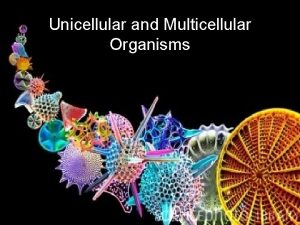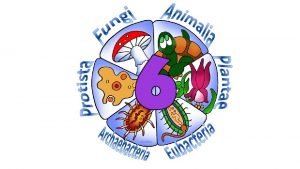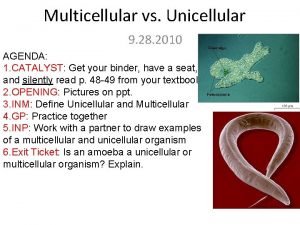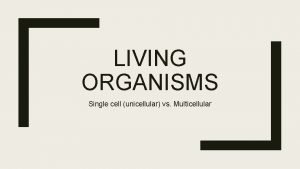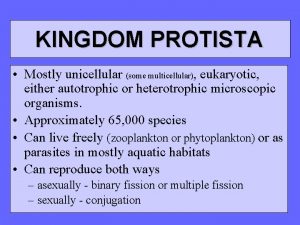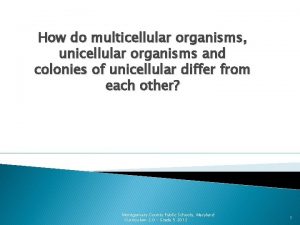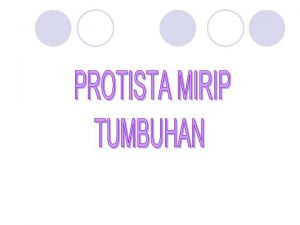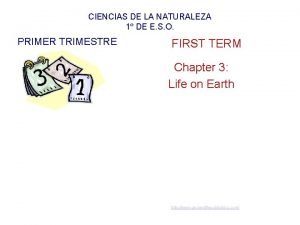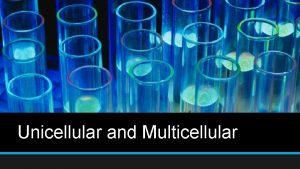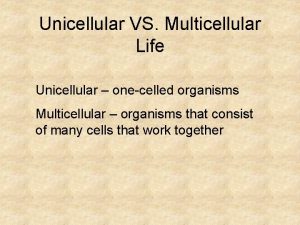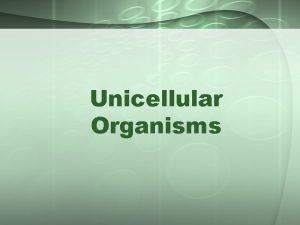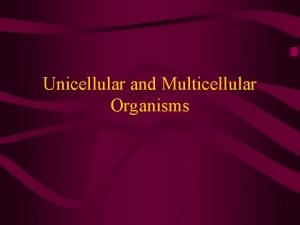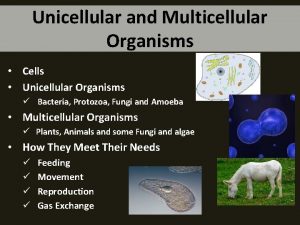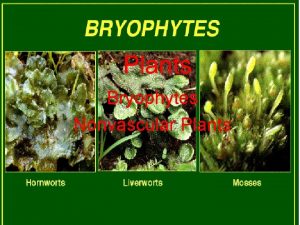Structure Unicellular or multicellular Nonvascular Same pigments as











- Slides: 11


Structure • • • Unicellular or multicellular Nonvascular Same pigments as vascular plants Double-membrane chloroplasts No centrioles Inner cell wall made of cellulose • • • Unicellular or Multicellular Nonvascular Same pigments as vascular plants Double-membrane chloroplasts No centrioles Cell wall made of cellulose • • • Red color from phycoerythrin Store energy as floridean starch Unstacked thylakoids Outer cell wall made of pectic acid No flagella • • • May live in colonies Store energy as starch Stacked thylakoids Cell walls made of cellulose Most have flagella

Diversity Domain: Eukarya Kingdom: Protista Phylum: Rhodophyta Domain: Eukarya Kingdom: Plantae Phylum: Chlorophyta, Charophyta

Nutrition and Metabolism • Photosynthesis • Floridean starch made in cytosol • Starch made in plastids Reproduction • Alternation of generations • Some reproduce asexually • Sperm lack flagella, so they depend on water currents to reproduce • Sexual reproduction by flagellated gametes

Uniqueness • Unstacked thylakoids and cytosolic floridean starch • Phycoerythrin allows it to live deeper in the water • Some can excrete calcium carbonate • Only algae to form pit connections after cytokinesis • Closest ancestor to vascular plants • Most common algae on land • Form symbiotic relationships with other organisms

Ecological Significance • Calcium carbonate used in bonereplacement therapy • Endosymbiotic with some organisms. • Used to expel intestinal worms • Carotenes may help treat or cause cancer • Agar used in foods and agarose gel • Carrageenan used for yogurt, chocolate milk, and puddings • Porphyra used in Japanese cuisine • Make up coral reefs • Help treat herpes simplex • Some are invasive or parasitic • Counter global warming

Examples Porphyra Trentepohlia P: Chlorophyta C: Ulvophyceae O: Trentepohliales F: Trentepohliaceae G: Trentepohlia P: Rhodophyta C: Rhodophyceae O: Bangiales F: Bangiaceae G: Porphyra Used to produce laver, gim, and nori. Parasitic on trees.

Examples Eucheuma P: Rhodophyta C: Rhodophyceae O: Gigartinales F: Areschougiaceae T: Eucheumatoideae Used to produce carrageenan, which is used in cosmetics and foods. Caulerpa P: Chlorophyta C: Bryopsidophyceae O: Bryopsidales F: Caulerpaceae G: Caulerpa Sea grapes. Used in East Asian cuisine

Examples Coralline Algae P: Rhodophyta C: Florideophyceae O: Corallinales Excrete calcium carbonate. Make up coral reefs. Volvox P: Chlorophyta C: Chlorophyceae O: Volvocales F: Volvocaceae G: Volvox Colonial algae.

Examples Gracilaria Dunaliella salina P: Rhodophyta C: Florideophyceae O: Gracilariales F: Graciliaraceae G: Gracilaria P: Chlorophyta C: Chlorophyceae O: Volvocales F: Dunaliellaceae G: Dunaliella S: D. salina Excrete calcium carbonate. Make up coral reefs. Halophilic. Creates large amounts of carotenoids and glycerol.

References Campbell, Neil A. , & Reece, Jane B. (2002). The Origins of Eukaryotic Diversity. Biology: Sixth edition (p. 565 -567). Sansome St. , San Francisco, CA: Benjamin Cummings. Freshwater, D. Wilson. (2000). Rhodophyta. Red Algae. The Tree of Life Web Project. Retrieved February 15, 2012 from: http: //tolweb. org/Rhodophyta/2381/2000. 03. 24. Guiry, Michael. (2011). The Seaweed Site: Information on marine algae. Retrieved February 15, 2012 from: http: //www. seaweed. ie/index. html. University of California Museum of Paleontology. (2012). The Protists. UGMP Taxon Lift. Retrieved February 15, 2012 from: http: //www. ucmp. berkeley. edu/help/index/protista. html. Gietler, Scott (photographer). (n. d. ). Garibaldi and Red Algae [Online image]. Retrieved February 15, 2012 from http: //www. uwphotographyguide. com/catalina-island-underwater. Pfaff, Sydney (utilizer). (2011). Ingredient Spotlight: Red Algae [Online image]. Retrieved February 15, 2012 from http: //blog. sephora. com/2011/04/ingredient-spotlight-red-algae. html Texas Department of Wildlife and Fisheries Sciences. (n. d. ). Muskgrass, Chara [Online image]. Retrieved February 15, 2012 from http: //aquaplant. tamu. edu/plant-identification/alphabetical-index/muskgrass / Wiegand, Alice (photographer). (2006). Nori [Online image]. Retrieved February 15, 2012 from http: //en. wikipedia. org/wiki/Nori. Navez, Bruno (photographer). (2007). Trentepohlia sp. on Cryptomeria japonica bark [Online image]. Retrieved February 15, 2012 from http: //en. wikipedia. org/wiki/Trentepohlia_(alga ) Bioted Biology Technology Devolopment (2012). Rong Nho [Online Image]. Retrieved February 15, 2012 from http: //bioted. vn/biofeed/? mode=news&id=325. The Seaweed Site: Information on Marine Algae. Iris Maerl [Image of purple algae]. Retrieved February 15, 2012 from http: //www. seaweed. ie/uses_ireland/irishmaerl. html National Ocean and Atmospheric Organization (photographer). (2010). [Image of brain coral and sea plumes]. Retrieved February 15, 2012 from http: //www. noaanews. noaa. gov/stories 2010/20100825_seaweb. html
 Unicellular and multi cellular
Unicellular and multi cellular Diatoms unicellular or multicellular
Diatoms unicellular or multicellular Examples of multicellular eukaryotes
Examples of multicellular eukaryotes Archaebacteria multicellular or unicellular
Archaebacteria multicellular or unicellular Is bacteria unicellular or multicellular
Is bacteria unicellular or multicellular Multi cellular organism
Multi cellular organism Protists unicellular or multicellular
Protists unicellular or multicellular Is protista unicellular or multicellular
Is protista unicellular or multicellular Capsulated fungi examples
Capsulated fungi examples Multicellular organism
Multicellular organism Ciri-ciri unisel dan multisel
Ciri-ciri unisel dan multisel Escherichia coli unicellular or multicellular
Escherichia coli unicellular or multicellular

